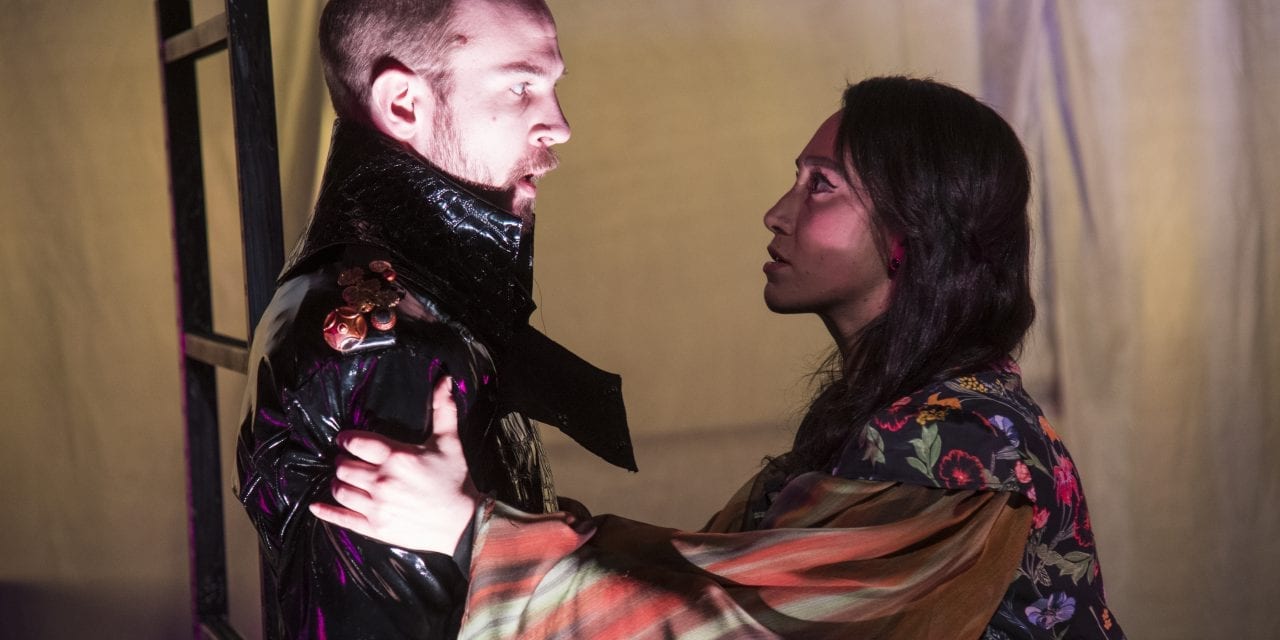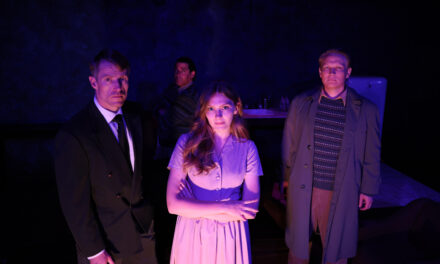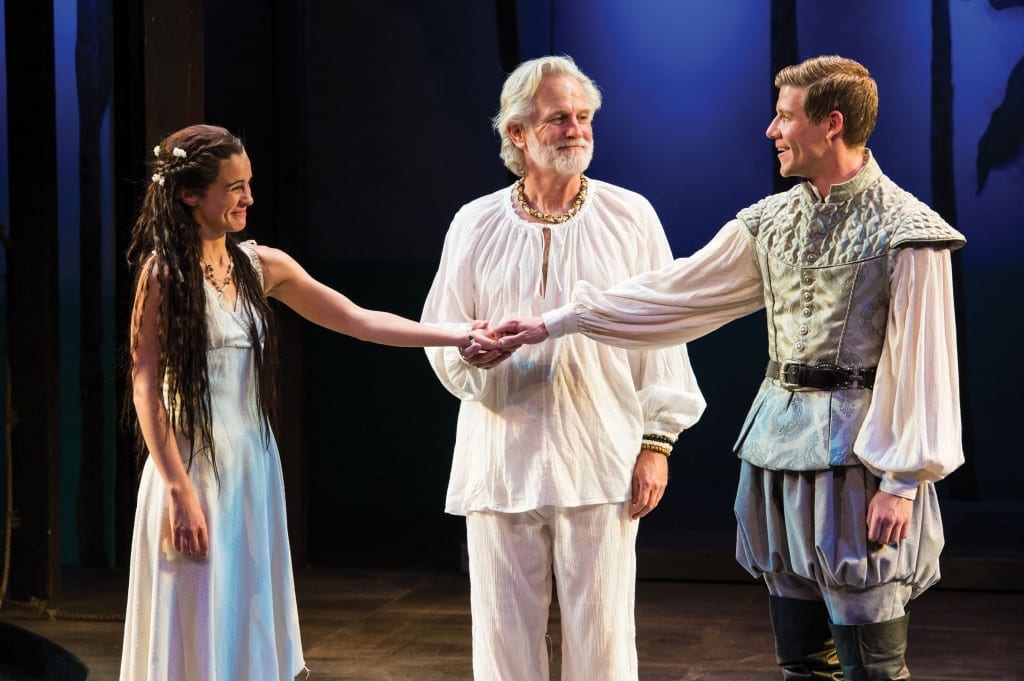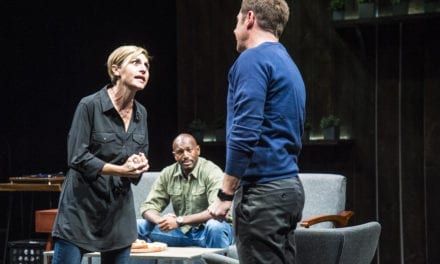WEST VALLEY CITY — In a world where youth are constantly looking down at their phones to watch the latest asinine YouTube video with a limited attention span, I wonder how it is possible to make rich and profound works like Shakespeare still accessible to the rising generation. This production of William Shakespeare‘s Macbeth, specially commissioned to take into schools, seeks to draw in young audiences and enchant them with this tragic tale of ambition and murder. With a trimmed script of a tight 75 minutes with no intermission, the play keeps a fast pace throughout. With fast action, superb acting, swordplay, shadow puppets, and a little rock-and-roll thrown in, young audiences will love this version of the Scottish play.

Touring show closes April 18, 2019.
Macbeth is a revered Scottish general who is returning from battle with his friend Banquo when the pair are given a dire prophecy from three witches. The witches predict that Macbeth will one day become King of Scotland and that Banquo will father a line of kings. Macbeth tells these predictions to his wife, who then spurs him into murdering King Duncan and seizing the throne. Consumed by ambition, Macbeth is forced to commit more and more murders until he becomes a crazed tyrant and the country is torn apart in civil war. Macbeth doesn’t fear this war because he is given promises from the witches that seem perfect until, one by one, they are all broken down and he is defeated.
Tim Sailer plays the title role astoundingly well. Sailer makes clear Macbeth’s doubts of what he is hearing in the witches’ predictions, and Sailer gives Macbeth a strong character arc as Macbeth commits treason and then embraces tyranny. Sailer as Macbeth’s scenes with Lady Macbeth, and his soliloquy where he sees a dagger in his mind that sends him on to do the deed and kill the king, were strong and enjoyable to watch. Macbeth’s soliloquy of, “tomorrow, and tomorrow, and tomorrow,” was a little flat and could have been given more range into how far Macbeth fell into despair and madness. Overall, Sailer was powerful and clear in his depiction of the cursed Scottish king.

Tim Sailer (left) as Macbeth and Stefanie Resnick as Lady Macbeth in the Utah Shakespeare Festival’s 2019 Shakespeare-in-the-Schools production of Macbeth.(Photo by Karl Hugh. Copyright Utah Shakespeare Festival 2019.)
The cast only consists of two men and four women. With Sailer playing Macbeth throughout, all the other actors had to play multiple roles often with quick costume changes. The witches were particularly delightful. With bizarre light-up glasses and ragged cloaks, the witches, played by Stefanie Resnick, Abigail Nakken, and Cordell Cole, danced to live drums and evoked a stomp vibe to their incantations. The use of shadows and puppetry made an excellent visual mirage that they displayed for Macbeth.
Playing the iconic role of Lady Macbeth is Resnick. She made some very interesting choices during her, “unsex me here,” speech, and she started it off by laughing and using a lighter tone before delving deeper and deeper as the speech went on. At first, I didn’t like this choice. However, since this is a production for schools, perhaps hearing, “unsex me here,” might be a part that gets strange reactions (snickering from teenage boys and such). Resnick’s choice works with that awkwardness and then guides the speech onward to the horrifying end it must arrive at. Resnick’s portrayal of Lady Macbeth’s descent into unnatural masculinity and eventual madness was superb.

Tim Sailer (left) as Macbeth and Jennifer Vosters as Malcolm in the Utah Shakespeare Festival’s 2019 Shakespeare-in-the-Schools production of Macbeth.(Photo by Karl Hugh. Copyright Utah Shakespeare Festival 2019.)
Often overlooked in intense tragedies like Macbeth is the use of comedy. The Porter’s scene was hilarious and had audience participation because it shows Shakespeare’s invention of the knock-knock joke. This light and funny respite in the pace made the turn to tragedy even more keenly felt.
The only negative of having a cast of four women and two men is that there were a few times that a traditionally masculine role can come across weaker. The depiction of a female Banquo was one of those few times, and although some of the other gender-neutral portrayals didn’t work perfectly, overall it was very smooth and worked well.
A stand-out performance was given by Cole in his role as Macduff. Cole’s depiction of a grieving husband and father learning the heart-rending news that his wife and children were murdered was poignant. He also deftly channeled the depiction of grief into rage for the final fight scene.

Abigail Nakken (left) as Murderer, Karen Thorla as Lady Macduff, Stefanie Resnick as Macduff Child, and Cordell Cole as Murderer in the Utah Shakespeare Festival’s 2019 Shakespeare-in-the-Schools production of Macbeth. (Photo by Karl Hugh. Copyright Utah Shakespeare Festival 2019.)
The set design by Benjamin Hohman was sparse and industrial, like a type of black-box, making the words of the play the focus. The set gives function and does not distract with any suggestion of a specific era. The use of fabrics to cast shadows and tell parts of the story was excellent. Steven Schmid offers interesting costume design full of plaid and pleather that seems, like the set design, to set the play outside of any given time. This timeless decision allows the audience to focus more on roles and relationships. With each actor taking on several different roles, the quick and efficient use of costume changes was critical to helping keep the audience straight on who they are playing and what side they are fighting on.
The sound design by Scott Palfreyman was an engaging and important element to keep the quick pace of the show moving. AC/DC songs (like, “Highway to Hell,” and, “Dirty Deeds Done Dirt Cheap,”) were interesting choices that gave apt descriptions of the main character’s trajectory throughout the play. During the 15-minute Q &A at the end of the play, Jennifer Vosters elaborated on this choice of music by explaining that, during Shakespeare’s time, people would have also been listening to the familiar top hits of the day. Using some of the top hits from today in the show is still very much in line with what Shakespeare was doing then.
Throughout the play there was a great use of shadow and light. The lighting design, also done by Palfreyman, was a perfect balance of simple and profound. The touring company must bring in all their own technical elements to each venue, lights included. Given this constraint, every choice was clear and purposeful. Flashes of red to symbolize murder were powerful. The production also used a lot of flashlights and shadow puppets to evoke a sense of other-worldliness, especially during the witches’ speeches and when Macbeth imagines the dagger before him.
This production excels in its purpose of trying to make Shakespeare relevant to youthful audiences and will be enjoyed by all ages. Director Michael Bahr’s vision comes through clearly. All the technical choices are sound and greatly contribute to making this a very relevant and modern production to take to the schools in the area. Above all, the words of the Bard shine throughout the excellent acting and leave the audience, young and old, reeling in the, “sound and fury,” of this production.





